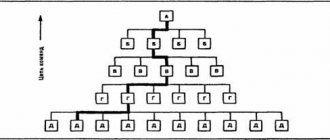Henri Fayol
Although Henri is the progenitor of this science, in fact, by education he had nothing to do with management. He was a mining engineer and worked for a long time in the French mining industry. Over time, he received the position of general manager. This happened in 1886, when Komombo was going to be declared bankrupt any day now. But a capable engineer managed to keep her afloat. And not just to retain, but also to ensure prosperity.
Henri retired in 1918, making his concern the most successful and, importantly, stable enterprise in France. As you remember, from 1914 to 1918 there was the First World War. And it was thanks to the existence of the mining plant that the country’s defense capability was maintained.
Therefore, it is not surprising that Henri was awarded a lot of awards, among which was the Order of the Legion of Honor. It was founded by Napoleon Bonaparte himself in 1802.
Reasons for the emergence of new management theories
In the Middle Ages and early modern times, no special management methods were required. But as a result of the industrial revolution and technological acceleration that occurred in the 18th-19th centuries, the situation changed. Even small factories and enterprises employed quite a lot of workers, which required the modernization of traditional management strategies.
Not only the increase in the number of workers, which occurred in parallel with the complication of business, posed new organizational tasks. An entrepreneur is primarily interested in the amount of profit he receives. It soon became clear that ineffective management leads to significant losses. To avoid them, rationalization was required.
Principles
Henri, thanks to his own experience in a leadership position, created a general system of principles relevant to any administrative activity. Regardless of the number of employees in the state, the salary level of each of them, motivation, etc. The basis of his concept was the existence of a material and social organism. Their harmonious connection with each other. That is, it is necessary to ensure not only high-quality working conditions, but also to establish communication between the participants in this process.
So, 14 principles:
Division of labor
In short and in simple words, it is a process when a complex task is broken down into several simple ones. Or the number of goals set is reduced. Thanks to the division of labor, the enterprise has the opportunity not only to increase the quantity of production, but also to significantly improve its quality.
Authority and Responsibility
The manager has the right to use the resources of the company for which he works. Also exercise power in relation to subordinates, coordinating their activities for the successful implementation of the goals and objectives of the enterprise. The manifestation of power is accomplished through demands and orders that employees do not challenge, despite the fact that their opinion regarding the manager’s idea may differ significantly.
But there is no power without responsibility. The one who organizes a process is responsible for its consequences, regardless of whether they turned out to be favorable or not.
Discipline
Without it there will be chaos and disorder. If employees do not adhere to the rules, they cannot be relied upon. Accordingly, what timeframes can we talk about for completing the assigned tasks? An agreement on the performance of duties between management and performers motivates strict adherence to boundaries. That is, for example, if an employee is late, he will be required to pay a fine. Five absences without good reason will result in dismissal.
Unity of management
Only one leader can give orders to subordinates. If management dualism arises, that is, when different managers formulate tasks for staff, there will definitely be a breakdown in work. This causes panic and anxiety.
Unity of management
In addition to the division of labor, it is important to create groups that will carry out the same program. Typically in organizations, such groups are divided into departments that are directly responsible for a specific “piece” of work. Each department must have its own head, who will supervise it.
Subordination of personal interests to common interests
If each employee considers his personal desires above the interests of the organization, it will ultimately suffer a sad fate. If the team works harmoniously for the benefit of the enterprise, then it will be able not only to satisfy its needs, but also to ensure professional growth for each of its participants.
Reward
In order to motivate staff to achieve and promote the company, remuneration must correspond to the efforts made and the level of responsibility. At least be at least fair. By the way, this rule also applies to managers themselves. The pressure that is put on them, with insufficient compensation for efforts, will quickly lead to professional burnout. And this threatens not only the health of the manager himself, but also affects the future of the company as a whole.
Centralization
With centralization, only top-level managers have the right to manage and make important decisions. Decentralization means that lower-level managers also bear responsibility through delegation of authority. So, it is important to maintain a balance between centralization and decentralization in order to anticipate an advantage in only one direction.
Hierarchy
It is also called a scalar chain. Without this principle, the rest will not be able to exist. Otherwise, there can be no talk of any subordination. The distribution of power is carried out depending on position in the hierarchy.
Order
Each employee should have his own place. Agree, it is difficult to fulfill your duties if the company has not taken care in advance and has not provided everything necessary for successful activities.
Justice
If a person receives an unfair punishment, he will no longer trust the person who made the verdict. Then there is no dedication, no desire to promote, develop the company and work for its benefit. Accordingly, administrative management also includes such a duty as fairness of decisions.
Job stability for employees
Personnel turnover has never been good for business. Yes, and it significantly affects the image, and not for the better. A successful leader keeps his staff in their place. And this gives stability and sustainability.
Initiative
When a person has the opportunity to demonstrate his abilities, he not only opens up, but also helps to find non-standard solutions to difficult situations. This allows the company to outperform its competitors and survive in difficult times of crisis. If initiative is punishable, the staff will only be a mediocre performer of their duties.
Corporate spirit
The microclimate in the team is very important. Otherwise, it will be possible to say that the conditions for successful activity have not been created. When it is not comfortable to be among colleagues, it is impossible to concentrate. Emotional states can interfere with cognitive processes. That is, thinking, attention, trying to remember or learn something.
Theories of organizational management
Evolution and change of technological structures are always associated with the development of science. But in this case we are not only talking about inventions that drive progress. Understanding the accumulated knowledge, including in the field of management, was the basis on which new organizational models were built.
Management theories began to appear at the dawn of the last century. All of them can be classified according to two criteria: by the method of their development and by the subject of research. In this regard, it can be noted that some of the theories of that time were created as a generalization of accumulated experience in the field of labor organization in production, while others appeared due to the transfer of advanced ideas of economics, psychology and sociology to a new environment.
Particularly interesting is the application of the principles of the last two sciences. Almost every author of one or another management theory paid attention to those aspects that had not been noticed before: the problems of interpersonal communication in production or the employee’s motivation to work and its stimulation. The organization of labor has ceased to be viewed as a kind of chaotic system in which feedback between workers and managers is not traceable. Instead, the connections that arise in production and their impact on the functioning of production itself were studied.
Meaning of Taylor's concept
Despite a number of criticisms, which are quite fair in their basis, Taylor's management theory is of undeniable importance in the history of management psychology. Its positive side, first of all, consisted in the abandonment of outdated methods of labor organization, as well as the creation of specialized training courses. The methods of personnel selection proposed by Taylor, as well as his fundamental requirement for regular re-certification, albeit modified to take into account new requirements, continue to exist to this day.
Taylor managed to create his own school dealing with problems of scientific management. His most famous followers are the spouses Frank and Lily Gilbert. In their works, they used movie cameras and microchronometers, thanks to which they were able to create practical recommendations for increasing labor productivity by reducing the amount of effort expended. Taylor's ideas about personnel selection were also widespread: Lily Gilbert is now considered the creator of the discipline of personnel management.
Although Taylor's school was exclusively concerned with increasing production efficiency at the grassroots levels, leaving aside the problems of intensifying the work of managers themselves, its activities became a turning point. The main provisions of Taylor's theory were quickly borrowed by foreign manufacturers who introduced it at their enterprises. The most important thing, perhaps, was that through his activities Taylor for the first time raised the question of improving management methodology. Since the publication of his book, this problem has been addressed by numerous scientific trends and schools, and new approaches to the organization of work appear to this day.
Frederick Taylor
An engineer by training, Taylor became a pioneer in introducing the principles of scientific management into production. He was born in 1856 in the small Pennsylvania town of Germantown into an educated family. Initially, he planned to become a lawyer, like his father, but a sharp deterioration in his vision did not allow him to continue his studies. Since 1878, Taylor became a laborer at the Midval steel mill. His career goes uphill: he very soon becomes a mechanic, and then heads several mechanical workshops.
Taylor learned the profession not only from the inside: in 1883 he received a diploma from the Institute of Technology. Even before the creation of his famous theory, F. Taylor became known as a specialist in the field of rationalization solutions. As soon as he received the position of chief engineer, he introduced a system of differential wages at the enterprise entrusted to him and immediately registered a patent for his innovation. In total, there were about a hundred such patents in his life.
Taylor's experiments
The theory of scientific management might not have come into existence if Taylor had not undertaken a series of tests of his observations. He saw their main goal as establishing quantitative relationships between productivity and the effort expended on it. The result of the experiments was the accumulation of empirical information necessary to develop methods for performing various tasks that arose before the worker during the labor process.
One of Taylor's most famous experiments was to determine the optimal amount of iron ore or coal that one worker could lift with shovels of various sizes without becoming incapacitated over a long period of time. As a result of careful calculations and several checks of the original data, Taylor determined that, under these conditions, the optimal weight was 9.5 kg.
Along the way, Taylor made an important point that the optimal weight is influenced not only by the time spent on the task, but also by the rest period.
The evolution of Taylor's views
From joining a steel mill as a simple worker to the publication of a fundamental work on management theory, a little over thirty years passed. Needless to say, over such a long period of time, Taylor's views changed due to the increase in knowledge and observations.
Initially, Taylor believed that to optimize production it was necessary to introduce the principle of piece payment. Its essence was that the employee’s initiative should be paid directly, which could be measured in units of time: how many products a person produced, for how much money he should receive.
Taylor soon revised this postulate. Experiments related to determining the optimal correlation between the efforts made and the result obtained allowed the researcher to state that in the production process, the most important control is not over labor productivity, but over the methods used. In this regard, he begins to develop practical recommendations for workers, and also sets new wage limits: the highest for hard work and the minimum for light work.
In the final phase of formulating his theory, Taylor became deeply involved in the scientific analysis of work activity. The reason for this was thinking about the formation of a certain body responsible for planning work activities at the enterprise. The very idea of decentralizing management based on competence required the identification of new grounds for control. These included the time spent on work, determining the complexity of a particular task, and establishing signs of quality.
Human factor
The excessive sociologization prescribed by F. Taylor's management theory was partly compensated by its attention to the individual worker, which management had not known before. It was not only about the developed principles of bonuses or taking into account individual abilities. Taylor's classical theory also provided for the need for professional selection and training of workers.
Since specific aptitude tests did not yet exist, Taylor developed them himself. For example, the speed test for product quality control workers was particularly used.
There was a certain patriarchy at the enterprises, manifested primarily in the fact that, in the spirit of the Middle Ages, young workers were trained by already experienced craftsmen. Instead, Taylor proposed developing specialized programs for training courses and advanced training courses.











